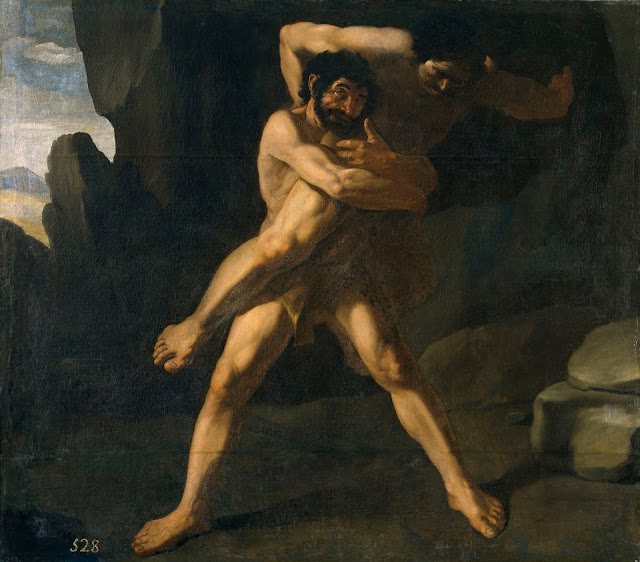 |
| Francisco de Zurbarán Hercules Separating the Mountains of Caspe & Abylla 1634 Prado |
"In June 1634 when Zurbarán's commission was first documented, it was to consist of twelve pictures representing the Labors of Hercules. It is clear from the document of final payment and the inventory of 1701 that the number was ultimately reduced to ten. The reduction of the commission must have been related in principle to the decision to place the pictures over the ten windows [in the newly built Hall of Realms at Buen Retire Palace outside Madrid]. At that point, it was presumably decided to change the nature and the purpose of this allegorical element in the series. As it now stands, the Hercules cycle seems somewhat disorganized. It contains seven major labors, two minor labors and an unusual representation of Hercules's death. But the apparent untidiness disappears as soon as the customary title, the Labors of Hercules, is discarded and its real meaning is discovered."
 |
| Francisco de Zurbarán Hercules Slaying King Geryon 1634 Prado |
"To the seventeenth-century mind, Hercules was a polyvalent symbol, a fact that the planners of the scenes for the Hall of Realms exploited to the hilt. First and foremost, Hercules was a popular symbol of Virtue and Strength, meanings that he had represented since antiquity. In the course of the sixteenth century, the virtuous and heroic Hercules was appropriated as a symbol of the prince following the antique example of the Emperor Augustus."
 |
| Francisco de Zurbarán Hercules & Antaeus 1634 Prado |
"A final idea was applied to the figure of Hercules by sixteenth-century rulers – Hercules as the conqueror of discord. The religious and political struggles of the period, and the divided loyalty of a sovereign's subjects, made the threat of discord loom large over the times. The extension of the Herculean metaphor to include the power to stifle rebellion was almost inevitable, and by the mid-sixteenth century the usual form for the symbol showed Hercules vanquishing a monster. In successive pictures, Hercules dispatches Antaeus, the Cretan Bull, the Erymanthian Boar, the Nemean Lion, the Lernean Hydra, and Cerberus – feats which were understood to symbolize the triumph of the just sovereign over his domestic and foreign enemies."
 |
| Francisco de Zurbarán Hercules & the Cretan Bull 1634 Prado |
"The symbolic significance of the Hercules scenes is crucial for understanding an artistic question that has long been puzzling. The choice of a specialist in religious art, who commanded an imposing but rigid style of painting, has always seemed somewhat illogical for these pagan subjects that were filled with action. But once the symbolic function of the Hercules pictures is grasped, the commission of Zurbarán makes sense. The Hercules scenes were emblemas and therefore invited a schematic treatment. The organizer of the decoration must have seen that Zurbarán's style was well suited to the task. The lack of finesse was offset by an almost blatant legibility of the kind commonly used in emblem books. In addition, the pictures had to be placed ten feet above the floor, which put a premium on clarity. The rough-hewn, unidealized Hercules type invented by Zurbarán captures in an original way the brute force and inexhaustible power of the ancient hero. His ability to triumph over discord is never in doubt."
 |
| Francisco de Zurbarán Hercules & the Erymanthian Boar 1634 Prado |
 |
| Francisco de Zurbarán Hercules & the Nemean Lion 1634 Prado |
 |
| Francisco de Zurbarán Hercules & the Lernean Hydra 1634 Prado |
 |
| Francisco de Zurbarán Hercules & Cerberus 1634 Prado |
 |
| Francisco de Zurbarán Hercules Diverting the River Alpheus 1634 Prado |
 |
| Francisco de Zurbarán Death of Hercules 1634 Prado |
"The dynastic motif is reemphasized in the Death of Hercules. Zurbarán's rendering of this episode is unusual because it combines two moments of Hercules's death agony into one. In most of the early accounts, Hercules put on the poisoned robe of Nessus, which caused unbearable pain when it came into contact with his skin, but did not break into flames. The robe caught fire only after Hercules had mounted the funeral pyre to end his mortal life and start his ascent to heaven and immortality. In his treatment of the final episode of Hercules's life, Zurbarán sacrifices textual fidelity to concentrate attention on the motif of the flames. By this device, Zurbarán evokes the ancient ritual of apotheosis in which Hercules, and therefore the King, becomes immortal."
All quotation by Jonathan Brown and J.H. Elliott from their book, A Palace for a King : The Buen Retiro and the Court of Philip IV (New Haven : Yale University Press, 1980).